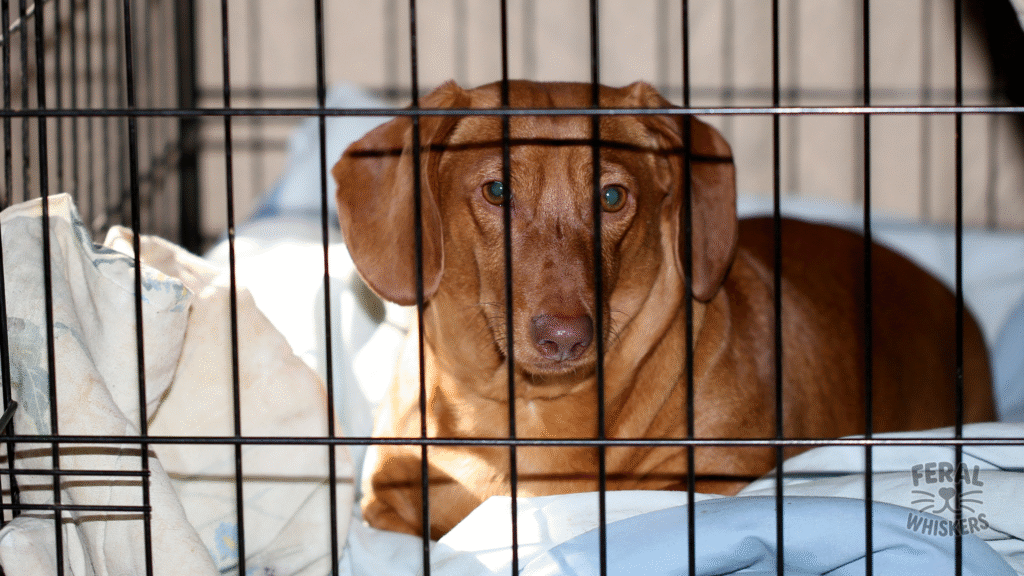Why Distemper Is So Dangerous

Canine distemper is one of the most lethal viral diseases dogs can face. Unlike parvovirus, which mainly attacks the stomach and intestines, distemper can damage the lungs, stomach, skin, brain, and nerves. This makes it harder to recover from, and sadly, many dogs do not survive even with treatment.
Mortality is high — studies estimate 50–70% of adult dogs and up to 80% of puppies may not make it. Those who survive often deal with lasting effects. This is why prevention through vaccination is far safer and more effective than relying on treatment.
How Dogs Catch Distemper
The virus spreads in many ways:
- Airborne droplets from sneezing, coughing, or barking
- Direct contact through shared food, water bowls, toys, or kennels
- Contaminated objects like bedding or clothing
- Wildlife reservoirs like raccoons, foxes, or coyotes that carry the virus
Because it spreads both through the air and on surfaces, just one sick dog in a shelter or daycare can infect dozens more.
Symptoms to Look Out For
Signs of distemper usually appear one to two weeks after exposure and can affect multiple parts of the body:
- Respiratory symptoms: runny eyes or nose, sneezing, coughing
- Digestive symptoms: vomiting, diarrhea, poor appetite, weight loss
- General symptoms: fever, lethargy, dehydration
- Skin and paws: thickened paw pads or crusty nose skin (“hard pad disease”)
- Neurological symptoms: twitching in the jaw or legs, head tilts, seizures, tremors, paralysis
Early signs can look like a mild cold or kennel cough, which can lead to delays in diagnosis if pet parents aren’t vigilant.
Diagnosis and Treatment
Vets diagnose distemper using history, exams, bloodwork, and swabs.
Treatment is about supporting the body through the infection, since there is no cure for the virus itself:
- IV or Sub‑Q fluids for hydration
- Anti‑nausea and anti‑diarrhea medicine
- Antibiotics to prevent secondary bacterial infections
- Anti‑seizure medications if the brain is affected
- Nutritional support when dogs won’t eat
- Plasma or serum transfusions in some cases — these provide antibodies from recovered dogs to boost the immune system. They can help but are not always effective.
Even with best efforts, some dogs may not survive, and survivors can be left with permanent issues.
Isolation and Hygiene

Because distemper spreads so easily, infected dogs must be isolated.
Isolation checklist:
- Keep the sick dog in a separate, closed‑off space.
- Use dedicated bowls, toys, bedding, and cleaning supplies.
- Wear gloves, wash hands, and change clothes after contact.
- Disinfect with products proven to kill distemper (accelerated hydrogen peroxide is more effective than bleach for this virus).
- Prevent your dog from coming into public spaces or meeting other pets.
If you visit or help care for a dog with distemper, always shower, change clothes, and disinfect before being near other dogs — especially puppies who haven’t finished vaccines.
Monitoring a Sick Dog at Home
Close monitoring helps vets track progress.
What to note daily:
- Temperature (normal: 101–102.5°F)
- Appetite and water intake
- Amount of vomiting or diarrhea
- Changes in energy or alertness
- Coughing, nasal or eye discharge
- Any muscle twitching, seizures, or balance issues
Keeping detailed notes helps catch declines early and guides your vet’s decisions.
Feeding and Hydration
Sick dogs often stop eating, but nutrition is vital.
- Offer bland foods like boiled chicken, white rice, or vet recovery diets.
- Feed very small portions frequently.
- Use syringe feeding only under vet guidance.
- Always monitor water intake — dehydration is deadly. If your dog won’t drink, a vet may teach you how to safely give Sub‑Q fluids at home for support.
Prevention Is Stronger Than Medicine
Because distemper is so deadly and unpredictable, prevention is the best safeguard.
- Vaccination is the #1 protection. Puppies start shots at 6–8 weeks, with boosters every 3–4 weeks until at least 16 weeks. A booster is given at one year, then every 1–3 years based on vet advice.
- Keep puppies out of dog parks, pet stores, and daycare until they are fully vaccinated.
- Reduce your dog’s risk of exposure to wildlife like raccoons or foxes.
- If you’ve been around a sick or shelter dog, disinfect yourself before going home.
Unlike treatment — which isn’t guaranteed — vaccines are over 90% effective in preventing distemper in the first place.
What to Expect if a Dog Survives Distemper
Not all survivors return to being fully healthy. Distemper can leave long‑term damage:
- Muscle twitching (distemper myoclonus): Involuntary jaw or leg movements, often permanent but not painful.
- Seizures: Some survivors develop epilepsy‑like seizures that require daily medication.
- Balance and coordination issues: Dogs may wobble, tilt their heads, or stumble.
- Dental damage: Puppies can grow in teeth with weak enamel or defects if infected while teething.
How to care for a distemper survivor:
- Stay consistent with vet appointments, especially if neurological signs remain.
- Use anti‑seizure medications as prescribed if needed.
- Provide a low‑stress, safe environment since excitement can worsen tremors.
- Offer gentle exercise but avoid strenuous activity.
- Maintain a nutritious diet to keep the immune system strong.
Many owners say their survivors form deeper bonds with them after recovery. With the right support, dogs with lasting tremors or quirks can still live loving, joyful lives.
Facts
- Distemper doesn’t just affect dogs — it impacts raccoons, skunks, and even lions.
- Before vaccines, distemper was the number one killer of dogs worldwide.
- In shelters, outbreaks can spread in days and devastate unvaccinated populations.
Common Questions
Is distemper worse than parvo?
Yes. Mortality can be higher, and survivors often deal with long‑term nerve or brain symptoms.
Can an older dog get distemper?
Yes, any unvaccinated dog is at risk, regardless of age.
What are the long‑term effects if my dog survives?
Permanent twitching, seizures, dental issues, and balance problems are common outcomes.
Can people catch distemper?
No, but humans can spread it to other dogs by carrying the virus on clothing or hands.
Is vaccination really enough?
Yes — vaccines are reliable and by far the best protection. Prevention is much safer and more effective than attempting treatment.
Final Takeaway
Canine distemper remains one of the most devastating diseases for dogs. With no cure, high mortality rates, and the risk of lifelong tremors or seizures even in survivors, it’s a nightmare illness for fur parents.
But it’s also highly preventable. Vaccination, good hygiene, and responsible socialization can protect your dog from ever facing this virus. If your pup does survive, know that while lasting symptoms like muscle twitching may remain, with patience, love, and veterinary care, they can still thrive and enjoy a full, happy life by your side.

